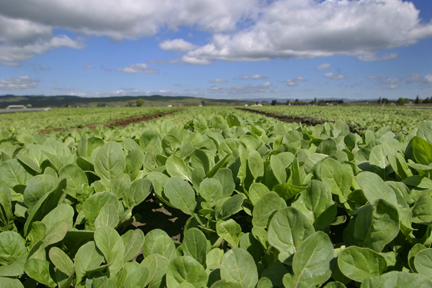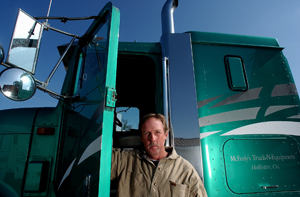Locals still in the dark about E. coli transmission after
six-month investigation
The green waves of leafy foliage along the interstate have an
uncertain future.
Locals still in the dark about E. coli transmission after six-month investigation
By Sneha Bhamre
Special to the Pinnacle
The green waves of leafy foliage along the interstate have an uncertain future.
The Food and Drug Administration and California’s Department of Health Services released a joint final report to the public March 23 concluding the six-month investigation of last September’s E. coli outbreak in fresh spinach. The report, “Investigation of an Escherichia coli O175:H7 Outbreak Associated with Dole Pre-Packaged Spinach,” revealed that San Benito County’s Mission Organics farm, located on Paicines Ranch, was responsible for the nationwide outbreak.
During last September’s outbreak, three people died and more than 200 others fell ill with food poisoning from E. coli strain O175:H7.
Among the possible sources suspected were irrigation water, feral pigs or cattle from neighboring lots. Dean Cliver, a professor of food safety at the University of California, Davis said the FDA report found cattle, the principal carrier for E. coli, were not in contact with the affected spinach.
“A lot more feral pigs were in the area than anyone cared to notice,” Cliver added.
The report also stated that the ground water level had dropped to the level of the river water in mid-summer 2006, making it another possible source of contamination.
For consumers and growers expecting decisive action from the report, the extent of federal response has left them in the lurch. Though local agricultural workers are satisfied with the FDA’s results, state and federal government officials believe that more should have been done.
While detailing every step of the painstaking investigative process, the FDA report failed to deliver two critical components, according to political officials – the exact source of the E. coli and decisive recommendations to the industry.
Congressman Sam Farr is one person who said he had hoped for regulation or industry recommendations.
“We still do not have any concrete answers and it is unclear why this report is only coming out now,” Farr said in a press release the day the report was issued, “Six months after the outbreak.”
Farr said his frustration with the FDA has been building for some time now. At a House Committee hearing at the beginning of March, the FDA director was unable to pinpoint a timeframe for the report’s release despite numerous inquiries by Farr on the matter.
“It’s very discouraging,” Farr said, “because they are essentially the food cops.”
According to Farr, the only thing that has become clear from this report is that more research is required.
The extent of the FDA’s conclusions have left the industry and state governments unsure of how to proceed. Distributors calling for more stringent production methods in order to minimize risk of another outbreak have made a range of demands. They have included requiring new fences around spinach fields and insisting on the removal of recycled water and compost mixed with manure from the growing process.
Since 1998, most growers have relied on guidelines called “Good Agricultural Practices.”
But good agricultural practices are a source of confusion among growers. Created by the FDA, GAPs are a collection of voluntary practices outlined in industry documents, meant to provide general food safety guidance at various production steps. According to Cliver, the GAPs are only suggestions, as they are more difficult to enforce than Good Manufacturing Practices.
“Everything is up in the air. Processors all have different restrictions,” said Paul Matulich, Agricultural Commissioner for San Benito Country.
Growers faced with uncertain market conditions are unable to predict future demand for spinach. Furthermore, implementing changes that will do nothing to ensure safe produce or decrease the risk of contamination are an unnecessary cost, according to Matulich.
For Assembly member Anna Caballero, the amount of circumstantial evidence in the FDA report is abundant.
Earlier this month, Caballero held a series of meetings with stakeholders in her district and in Sacramento.
“I called this meeting to get the perspective of local farmers, researchers, water quality and land use experts and environmentalists about what they have learned since this E. coli outbreak occurred,” said Caballero, in a press release issued March 8, “And what they believe must be done to ensure the safety of our food supply.”
Caballero’s main concern is that before California growers choose to take any action, good scientific information needs to be the basis for any decision made.
She is working to propose a bill using $10 million of state and federal money for UC research on food safety at the beginning of the next fiscal year. Farr has similarly introduced a bill, H.R. 912 that authorizes $26 million for food safety research for fresh produce and emergency assistance funds for producers and handlers who suffered losses from pulling fresh spinach off the market.
Since September the produce industry has been trying to find its own means of rectifying the situation.
“The industry has already made a lot of changes to ensure that another outbreak does not happen again,” Matulich said.
Producers have started the “Leafy Greens Handler Marketing Initiative,” a program with specific growing and production methods that decrease the probability of cross-contamination. Voted on March 23 to follow all of the GAP protocols, the program will go into full effect April 1st. Each producer will pay a fee to have their product checked by a U. S. Department of Agriculture inspector before receiving a seal of approval.
“98 percent of the handlers of spinach and green leaf lettuce are involved in the program,” Matulich said.
Other distributors, such as San Benito Earthbound Farms and Natural Selection Foods, are using their own methods to increase the safety of their produce. The company has implemented many checkpoints since September, including frequently checking the irrigation water and soil for pathogens, as well as all the seed lots.
In processing facilities, the company has implemented the most rigorous protocol approved by the International Commission on Microbial Specifications for Food and follows GAP guidelines.
Samantha Cabaluna, the director of communications at Earthbound Farms and Natural Selection Foods agrees that standardization of protocols, similar to how organic produce was standardized is easier for consumers to understand.
“We welcome regulation,” Cabaluna said, “National regulation [would be] better than statewide patchwork protocols.”
On the other side, regulation takes time and the produce industry has to move forward while that happens, Cabaluna said. All of the growers who work with Earthbound Farms have been receptive to the company’s requests, according to Cabaluna. The company makes individual site assessments before making requirements for each farm, Cabaluna said, because each farm’s layout needs to be taken into account.
Consumer groups are concerned about the industry setting the standard, Caballero said.
The Center for Science in the Public Interest wants the FDA to regulate and mandate standards for farm sanitation
“I agree, but the challenge right now is that no one can definitively say what the best practices are,”Caballero said.
The industry is looking for direction, according to Farr, and right now the FDA has not told them where to start.
“[It’s] not a blame game. Victims blame farmers and farmers blame other farmers” Farr said. “The responsible role would be to find the root cause of the problem and fix it.”








